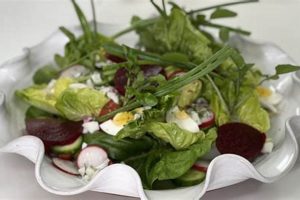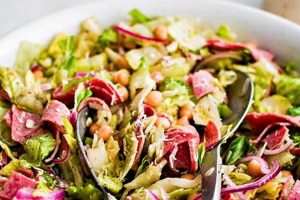Lacinato kale, often called dinosaur kale due to its textured, bumpy leaves resembling reptilian skin, forms the base of numerous salads. These salads offer a versatile platform for culinary creativity, incorporating various ingredients like fruits, vegetables, nuts, cheeses, and proteins, along with a wide range of dressings. For instance, a common preparation combines chopped lacinato kale with dried cranberries, toasted pecans, crumbled goat cheese, and a lemon vinaigrette.
This leafy green boasts a robust nutritional profile, rich in vitamins A, C, and K, as well as fiber and antioxidants. Its inclusion in salads contributes to dietary health, promoting digestion and overall well-being. While its popularity has surged in recent years, lacinato kale has a long history, cultivated for centuries in Tuscany and enjoying renewed appreciation in contemporary cuisine for its hearty texture and earthy flavor.
Further exploration will cover specific preparation techniques, including massaging the leaves to tenderize them, and address the versatility of lacinato kale in accommodating diverse flavor profiles and dietary needs, from vegan and vegetarian options to those incorporating meat or fish.
Tips for Preparing Lacinato Kale Salads
Maximizing the culinary potential of lacinato kale requires attention to key preparation techniques and ingredient pairings. These tips offer guidance for creating flavorful and satisfying salads.
Tip 1: Massage the Kale: Massaging the leaves with a small amount of olive oil and a pinch of salt for a few minutes tenderizes the kale, reducing its inherent bitterness and creating a more palatable texture.
Tip 2: Balance Flavors: Lacinato kale’s earthy flavor pairs well with contrasting tastes. Consider incorporating sweet elements like dried fruit or roasted vegetables, tangy additions such as citrus vinaigrette or crumbled cheese, and crunchy textures like toasted nuts or seeds.
Tip 3: Choose Complementary Dressings: Opt for dressings that enhance rather than overpower the kale’s flavor. Lemon vinaigrette, tahini dressing, and creamy dressings based on avocado or Greek yogurt are excellent choices.
Tip 4: Don’t Overcrowd the Salad: Allow space for each ingredient to shine. Avoid adding excessive amounts of any single component, ensuring a balanced and visually appealing presentation.
Tip 5: Consider Prepping Ahead: While best consumed fresh, the massaged kale can be prepared a few hours in advance and stored in an airtight container in the refrigerator, allowing the flavors to meld.
Tip 6: Explore Different Ingredient Combinations: Lacinato kale provides a versatile base for diverse flavors. Experiment with various fruits, vegetables, proteins, and cheeses to discover preferred combinations.
Tip 7: Proper Storage: Store unwashed lacinato kale in a plastic bag in the refrigerator’s crisper drawer for optimal freshness.
By following these tips, culinary enthusiasts can elevate simple lacinato kale into flavorful and nutritious salads that contribute to a well-rounded diet.
These preparatory steps and serving suggestions offer a foundation for incorporating lacinato kale into a variety of healthy and enjoyable meals.
1. Fresh, High-Quality Kale
The foundation of any successful dino kale salad lies in the quality of the kale itself. Fresh, high-quality kale provides optimal flavor, texture, and nutritional value, significantly impacting the overall culinary experience. Selecting and handling kale correctly ensures a vibrant and satisfying salad.
- Visual Indicators of Freshness
Vibrant, deep green leaves with minimal discoloration or wilting signify fresh kale. Avoid bunches with yellowing or browning leaves, as these indicate age or improper storage. Crisp, firm stems further suggest freshness. These visual cues aid in selecting the best kale for salads, contributing to optimal flavor and texture.
- Sourcing and Storage
Farmers’ markets often offer the freshest, locally sourced kale. Alternatively, reputable grocery stores typically stock high-quality kale. Proper storage is crucial for maintaining freshness. Store unwashed kale in a loosely sealed bag in the refrigerator’s crisper drawer. Proper storage extends shelf life and preserves nutritional content.
- Impact on Flavor and Texture
Fresh kale offers a robust, earthy flavor, while older kale can develop bitterness. The texture of fresh kale is firm yet pliable, ideal for massaging and incorporating into salads. Using fresh kale ensures a pleasant culinary experience, minimizing bitterness and maximizing textural appeal. This contributes significantly to the overall enjoyment of the salad.
- Nutritional Value
Fresh kale contains higher concentrations of vitamins, minerals, and antioxidants compared to older, less vibrant leaves. Consuming fresh kale maximizes the nutritional benefits associated with this leafy green, contributing to a healthy diet. This reinforces the importance of selecting fresh kale for salads, emphasizing its health benefits.
Prioritizing fresh, high-quality kale elevates dino kale salad recipes from simple dishes to vibrant, nutrient-rich culinary experiences. The care taken in selecting and handling the kale directly translates to a more flavorful, texturally appealing, and nutritionally beneficial salad.
2. Complementary Ingredients
The robust, earthy flavor of lacinato kale, commonly referred to as dino kale, necessitates careful consideration of complementary ingredients to create a balanced and palatable salad. Strategic ingredient pairings enhance the kale’s inherent qualities while mitigating potential bitterness and adding textural complexity. The following facets explore crucial components that contribute to a well-rounded dino kale salad.
- Balancing Flavors
Lacinato kale’s inherent earthiness benefits from ingredients that provide contrasting flavor profiles. Sweet elements, such as dried fruits like cranberries or raisins, or roasted sweet potatoes, offer a counterpoint to the kale’s savory notes. Tangy components, like crumbled goat cheese or a citrus vinaigrette, cut through the richness and add brightness. These contrasting flavors create a more nuanced and enjoyable salad experience.
- Textural Variety
The somewhat coarse texture of lacinato kale is enhanced by incorporating ingredients that introduce textural contrast. Toasted nuts, such as almonds, walnuts, or pecans, offer a satisfying crunch. Seeds, like sunflower or pumpkin seeds, provide a similar textural element. Crispy vegetables, such as shredded carrots or bell peppers, add a refreshing crispness. These varied textures create a more dynamic and engaging mouthfeel.
- Protein and Healthy Fats
Adding protein and healthy fats transforms a dino kale salad into a complete and satisfying meal. Grilled chicken or fish provides lean protein. Legumes, such as chickpeas or lentils, offer a plant-based protein source. Avocado adds healthy fats and a creamy texture. Nuts and seeds contribute both protein and healthy fats, enhancing nutritional value and promoting satiety.
- Seasonality and Regional Influences
Utilizing seasonal ingredients elevates the flavor profile of a dino kale salad. Incorporating fresh, locally sourced produce when available maximizes flavor and nutritional content. Regional influences can also inspire ingredient choices. Mediterranean-inspired additions, such as olives, feta cheese, and sun-dried tomatoes, complement the kale’s inherent flavors. Exploring seasonal and regional variations allows for diverse and exciting salad combinations.
The careful selection of complementary ingredients elevates dino kale salads beyond basic greens, transforming them into complex and satisfying culinary creations. By balancing flavors, textures, and nutritional components, these additions create a symphony of tastes and textures that enhance the overall dining experience while maximizing the nutritional benefits of this versatile leafy green.
3. Flavorful Dressings
Flavorful dressings play a crucial role in successful dino kale salad recipes. The inherent robust, sometimes bitter, flavor of lacinato kale necessitates a dressing that not only complements but also balances its earthiness. A well-chosen dressing can transform the kale from a simple base into a delectable culinary experience. The following facets explore the key components and considerations for crafting and selecting dressings perfectly suited to dino kale salads.
- Balancing Acidity and Sweetness
The right balance of acidity and sweetness is paramount in a dino kale salad dressing. Acidity, derived from ingredients like vinegar or citrus juice, cuts through the kale’s richness and adds brightness. Sweetness, often incorporated through honey, maple syrup, or fruit juices, tempers the acidity and complements the kale’s earthy notes. A harmonious blend of these elements prevents the dressing from overpowering the kale’s flavor while enhancing its inherent qualities. For example, a lemon vinaigrette with a touch of honey provides a classic balance.
- Complementing the Kale’s Flavor Profile
Dressings should enhance, not mask, the kale’s distinctive flavor. Earthy dressings, such as those incorporating tahini or roasted nuts, can amplify the kale’s natural earthiness. Bright, citrus-based dressings offer a refreshing contrast. Creamy dressings, based on avocado, Greek yogurt, or buttermilk, provide a richer, smoother counterpoint. The choice of dressing depends on the desired overall flavor profile of the salad.
- Texture and Consistency
The texture and consistency of the dressing influence how it interacts with the kale. A vinaigrette provides a light, tangy coating, while a creamy dressing clings more readily to the leaves. Thicker dressings can help tenderize the kale, particularly if massaged into the leaves prior to serving. The desired texture contributes to the overall sensory experience of the salad.
- Oil Selection
The choice of oil impacts both the flavor and nutritional value of the dressing. Extra virgin olive oil offers a robust flavor and healthy fats. Avocado oil provides a neutral flavor and a high smoke point, suitable for certain preparations. Nut oils, such as walnut or hazelnut oil, impart distinctive flavors that can complement specific ingredient combinations. Careful oil selection contributes to the overall harmony of the salad.
The careful consideration of these elements ensures that the dressing not only complements the dino kale but also unifies the various ingredients into a cohesive and flavorful salad. A thoughtfully crafted dressing elevates dino kale from a simple green to a star ingredient, demonstrating the transformative power of flavor pairings in culinary creations.
4. Proper Preparation Techniques
Proper preparation techniques are essential for optimizing both the flavor and texture of lacinato kale, commonly known as dino kale, in salad recipes. This leafy green possesses a robust, sometimes bitter, flavor and a hearty texture that benefits from specific handling. The absence of proper preparation can result in a tough, unpalatable salad, while correct techniques unlock the kale’s full culinary potential, transforming it into a tender and flavorful base. For instance, neglecting to massage the kale leaves can leave them fibrous and difficult to chew, whereas massaging them with olive oil and salt tenderizes the leaves, reducing bitterness and enhancing palatability.
Several key techniques contribute to a successful dino kale salad. Thorough washing and drying remove any residual grit or debris, ensuring a pleasant eating experience. The thick stems, often too fibrous for salads, require removal before chopping or tearing the leaves. Chopping the leaves into bite-sized pieces facilitates even coating with dressing and comfortable consumption. Perhaps most crucial is the technique of massaging the kale. This process involves gently rubbing the leaves with a small amount of oil and salt, breaking down the cell walls and softening the texture. Massaging also reduces the kale’s inherent bitterness, making it more palatable. Finally, allowing the massaged kale to rest for a period, typically 15-30 minutes, further enhances its tenderness and allows the flavors to meld.
Mastery of these techniques represents a critical step in creating delicious and enjoyable dino kale salads. The difference between properly prepared and improperly prepared kale is significant, impacting both the texture and flavor of the final dish. By understanding and implementing these techniques, one ensures that the kale contributes positively to the overall culinary experience, transforming a potentially tough and bitter green into a tender, flavorful, and satisfying salad base.
5. Creative Flavor Combinations
Creative flavor combinations are essential for elevating dino kale salad recipes beyond the ordinary. Lacinato kale’s robust flavor profile provides a versatile canvas for culinary exploration, allowing for a wide range of pairings. The inherent slight bitterness of the kale necessitates thoughtful combinations that balance and enhance its taste, rather than masking it. This necessitates moving beyond basic additions and exploring diverse ingredients and flavor profiles. For example, the earthiness of kale pairs well with the sweetness of roasted butternut squash and the tang of crumbled goat cheese, creating a balanced and complex flavor profile. Similarly, the peppery notes of a radish and the richness of toasted walnuts complement the kale’s inherent bitterness, offering a contrasting yet harmonious flavor experience.
Successful flavor combinations often involve a interplay of contrasting yet complementary tastes and textures. Sweet and savory elements, such as dried cranberries paired with a Dijon vinaigrette, create a dynamic flavor profile. Crunchy elements like toasted nuts or seeds provide textural contrast to the kale’s somewhat coarse leaves. Acidity from citrus fruits or vinegar brightens the overall flavor and cuts through the kale’s richness. Incorporating umami-rich ingredients like sun-dried tomatoes or Parmesan cheese adds depth and complexity. The key lies in achieving balance, ensuring that no single flavor dominates the others. Consider a salad combining massaged kale with roasted Brussels sprouts, toasted pecans, crumbled blue cheese, and a maple-balsamic vinaigrette. The slight bitterness of the kale and Brussels sprouts is balanced by the sweetness of the maple syrup and the tang of the blue cheese, while the pecans provide a satisfying crunch.
Culinary creativity with dino kale salads allows exploration of diverse global cuisines. Asian-inspired salads might incorporate ingredients like mandarin oranges, edamame, and a sesame-ginger dressing. Mediterranean influences could include Kalamata olives, feta cheese, and a lemon-herb vinaigrette. The possibilities are vast, limited only by culinary imagination. Strategic flavor combinations transform dino kale salads into exciting culinary experiences that highlight the versatility of this nutritious green. Achieving such complexity requires an understanding of flavor profiles and a willingness to experiment with diverse ingredients and textures, ultimately elevating a simple salad into a sophisticated and satisfying dish.
Frequently Asked Questions About Lacinato Kale Salads
This section addresses common inquiries regarding the preparation and enjoyment of lacinato kale salads, aiming to provide clear and concise information.
Question 1: How can the bitterness of lacinato kale be mitigated?
Massaging the leaves with olive oil and a pinch of salt for several minutes helps break down the cell walls, reducing bitterness and improving texture.
Question 2: What are suitable dressing options for lacinato kale salads?
Lemon vinaigrette, tahini dressing, creamy avocado dressing, and Greek yogurt-based dressings complement lacinato kale’s flavor profile.
Question 3: How should lacinato kale be stored for optimal freshness?
Store unwashed leaves in a sealed bag or container in the refrigerator’s crisper drawer for up to five days.
Question 4: Can lacinato kale salads be prepared in advance?
While best consumed fresh, massaged kale can be stored in an airtight container in the refrigerator for a few hours before adding other ingredients and dressing.
Question 5: What are some complementary ingredients for lacinato kale salads?
Dried fruits, toasted nuts, seeds, crumbled cheese, roasted vegetables, and lean proteins pair well with lacinato kale.
Question 6: How does lacinato kale compare nutritionally to other leafy greens?
Lacinato kale is a nutritional powerhouse, rich in vitamins A, C, and K, as well as fiber and antioxidants.
Understanding these aspects contributes to successful preparation and enjoyment of lacinato kale salads. Proper handling and thoughtful ingredient pairings maximize both flavor and nutritional benefits.
This information provides a foundation for incorporating lacinato kale into a diverse and healthy diet. Experimentation with various recipes and flavor combinations allows for personalized culinary experiences.
Dino Kale Salad Recipes
Exploration of lacinato kale salad recipes reveals a versatile culinary landscape. From the importance of ingredient selection and preparation techniques to the art of balancing flavors and textures, crafting a compelling salad hinges on a nuanced understanding of this leafy green’s unique characteristics. Proper handling, including massaging the leaves, unlocks optimal flavor and texture. Strategic pairings with complementary ingredients, such as dried fruits, toasted nuts, and flavorful cheeses, elevate the kale’s inherent earthiness. Thoughtful dressing choices further enhance the overall culinary experience.
The nutritional richness of lacinato kale, coupled with its culinary versatility, positions it as a valuable addition to any diet. Continued exploration of flavor profiles and innovative recipe development promises to further expand the culinary possibilities of this remarkable green. Embracing a mindful approach to preparation and ingredient selection unlocks the full potential of lacinato kale, transforming a simple salad into a sophisticated and healthful culinary creation.






